- Offensive Techniques & Strategies
Princeton Offense
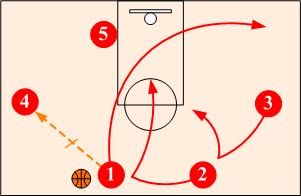
What you will discover or recall:
The Princeton offense is not really an offense at all in the true sense, but rather an unstructured style of play. Very similar to the Passing Game offense, rather than relying upon executing a set pattern or play, the Princeton Offense relies purely on constant motion and specific counter actions based on defensive reads to create open shot opportunities with the classic back door cut for an easy basket being its signature option. Developed and popularized over the years by Pete Carril, all five players are totally involved in the offense at all times. This is why it is so enjoyable to watch and coach.
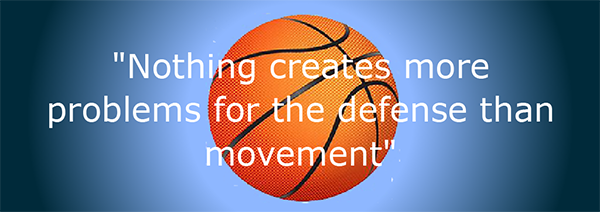
Since the Princeton offense is a team oriented offense, it provides for a maximum effort within the limits of a team's athleticism. It does require players that can shoot well from the outside, pass and drive with either hand, and possess good court savvy. In addition, all players must develop an unselfish attitude and work hard to create open shots opportunities for their teammates. This is accomplished by having patience and controlling the ball. Because of this constant player movement superior physical conditioning is a very important ingredient to its success.
| Commitment | Adaptability | Spacing | Continuity |
Offensive Fundamentals Required
Raising Your Level of Passing - Click Here
Creating Leads - Techniques to Get Open - Click Here
Executing Back Cuts - Click Here
Setting & Using Off Ball Screens - Click Here
Offensive Rebounding Techniques - Click Here
Schematic Sequence

Coach's Commitment & Benefits
Coaches must be sold on the Princeton Offense. It involves the "All or None Principle." Do not try to employ it, if you are not sure or are not entirely committed. In giving players the freedom to create, coaches may a feel a real loss of offensive control at first, but as the season progresses, they will soon realize and appreciate the advantages and full potential of a non-structured offense. In addition, the Princeton Offense provides for the following added benefits:
Teaches the value and benefits of teamwork.
Practicing basic ball handling and shooting skills daily.
Practicing defensive fundamentals against offensive movement and back cuts daily.
Never having to reset the offense or call out plays.
Movement makes it harder for the defense to block out.
It is tough to scout because it is not predictable.
Adaptability
The Princeton offense is adaptable to attacking any type of defenses. Most opponent game plans include playing aggressively and extending defensive pressure in effort to disrupt and speed up game tempo; however, with the middle of the court wide open, this plays right into the hands of the Princeton Offense which is loaded with back cut reads. The real strength of the Princeton Offense, strong outside shooting along with offensive patience, will punish any team that elects to play a sagging man to man or zone defense.
Spacing
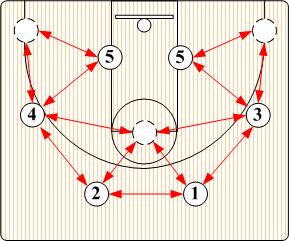
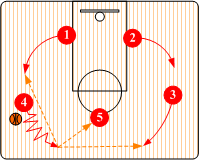
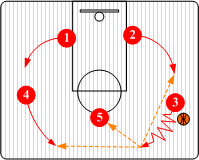
Spacing is a crucial element and a key factor of the Princeton Offense. Players must be aware of proper spacing at all times, and, if necessary, use their dribble to maintain proper spacing. Players are spaced between 12 and 15 feet at all times. This precise spacing spreads the defense in order to prevent or discourage any defensive help or double teaming, and at the same time it provides for sharp, accurate passing. This spreading of the defense also clears out the basket area allowing for one-on-one post play, drives, basket cuts, slice cuts, and post splits. A a result, the defense is forced to defend the entire court from sideline to sideline at all times.
Basic Continuity
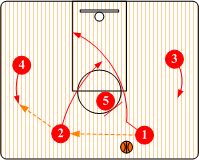
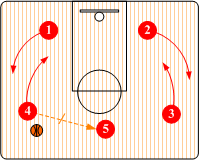
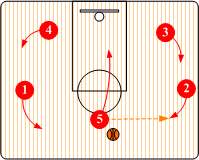
One of the nice things about the Princeton offense is that it is very flexible in that it can be initiated with almost any type of entry. It can be ran out of a variety of alignments, and can be adaptable to most offensive schemes. The Princeton Offense spreads the court by keeping everyone above the free throw line except for basket cuts. This high alignment not only forces the defense to defend the entire court, but it also eliminates any weakside defensive help.
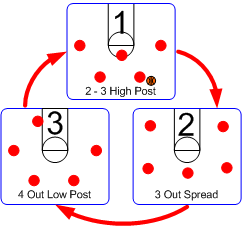
The Princeton Offense normally starts out in a 2-3 high post alignment. Basic action is begins on either side of the court by executing any one of the various pass or dribble entries available. Phase two consists of a series of exchanges and/or down screens. In Phase three, is initiated with the high post making a basket cut. Phase one repeats with post flashing to the middle for possible back door action. If/when the back door is not available, the basic action continues by flowing directly into another entry.
| Entries | Exchanges | Post Play | Spacing | Tempo | Specials | Psychology Benefits |

Phase 1. Entries
The Prince Offense entries are automatic and are triggered by the ballhandler's entry pass or dribble penetration. On a pass to wing the ball handler makes a "Give & Go" The guard to guard pass keys an off guard shuffle or Hawk cut. A post pass initiates high post split action. Dribble entries include mid screen, dribble clear, and dribble weave options. The off guard (Hawk) and high post rub (UCLA) are the most commonly used entries to initiate the offense. However, recently, the Mid Screen entry is becoming the entry of choice. All entries can be ran equally on both sides of the floor.
| Off Guard Rub | Point Rub | Mid Screen | Dribble Clear | Zipper | High Post |
Weakside Guard Rub
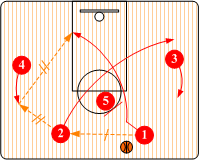
Ballhandler O1 passes to O2 and rubs off O5's high post screen to basket. O2 passes to wing O4 and cuts to opposite corner.

If O1 is not open on basket cut or post up, 04 passes out to O5 initiating wing exchanges or down screens.
Point Guard Post Rub
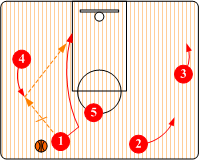
Strong side guard O1 makes a wing entry pass to O4 and rubs off O5's high post screen to basket. Note: O1 also has option of making a direct "Give & Go" cut to basket.
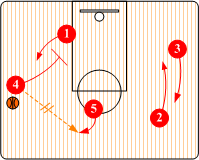
If/when O4 cannot pass to O1, O4 makes a reversal pass out to O5 initiating wing exchanges or down screen action.
Mid Screen Entry
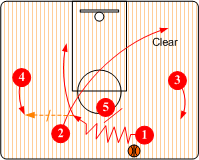
O2 clears to opposite corner as ballhandler O1 drives off O5's high post screen. O1 has option or turning the corner and driving to the basket or passing to wing o4 and cutting to the basket.
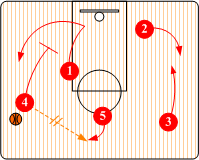
If/when O4 cannot pass to O1, O4 makes a reversal pass out to O5 initiating wing exchanges or down screens.
Dribble Clear Entry
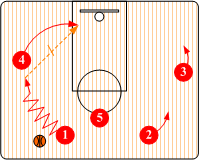
O1 dribbles clears wing O4. O1 looks to feed O4 on back cut to basket or post up.
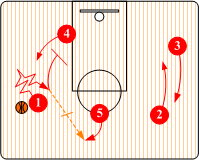
If wing o4 is not open, 01 makes a reversal pass out to O5 initiating wing exchanges or down screen action.
Zipper Entry - Wing Loop
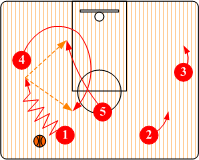
O1 dribble clears wing O4 as high post O5 rolls down to set a down screen. O1 looks to feed O4 popping out or O5 posting up against a smaller defender if the defense switches.
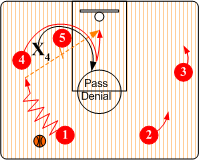
If defender X4 should over play and deny the passing lane, O4 immediately back cuts to basket for an over the top lob pass from O1.
High Post Entry
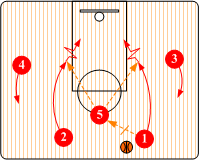
Ball handler O1 passes to high post O5. O1 and O2 cut directly to basket looking for possible feed from O5.
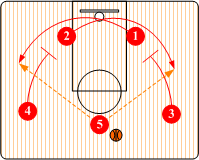
If not open on basket cuts, O3 and O4 set down screens for O1 and O2 crossing under the basket. Note: O1 and O2 have option of faking the cross and popping out directly off of O3's and O4's down screens.

Phase 2. Exchanges
Exchanges and constant ball movement are the heart of the offense. This phase is where the majority of ball control takes place. This constant motion sets up the open back cuts and " Give & Go" cuts which are the trademarks of the Princeton Offense.

Wing Exchanges
If O4 does not pass to O1, O4 makes a reversal pass out to O5. Wings O3 and O4 then exchange with O1 and O2. O5 looks to feed O1 or O2 for an open shot. Note: O5 should be alert to pass to either O3 or O4 on a basket cut anytime their defender loses vision on the ball.
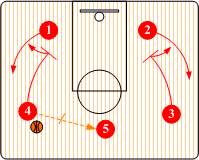
Down Screens
On pass out to O5, O3 and O4 have option of setting down screens with O1 and O2 rather than exchanging. After screening O3 and O4 pop out to keep middle open.
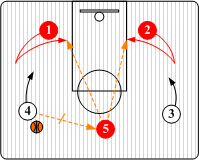
Back Cuts
On O4's pass out to O5, any time O1 or O2 are overplayed or the defense anticipates the exchange, O1 and O2 have the option of back cutting to the basket rather than coming off a down screen or exchanging.

Base Cross
If not open on basket cuts, O1 and O2 have option of crossing under the basket. This is especially effective on the high post entry. Note: O1 and O2 also have the option of faking the cross and popping out directly off of O3's and O4's down screens.
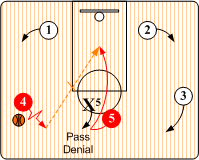
Post Back Cut
Any time the pass out to O5 is overplayed or denied, O5 quickly back cuts to basket for shot
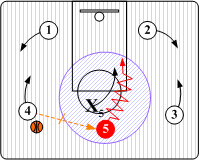
Post 1-on-1 Isolation
O5 always has green light to drive hard to the basket when O5 can beat the defender. O5 also has an open shot opportunity if the defender sags off.

Phase 3. Post Action
Anytime the high post makes a basket cut, the offense flows into a four out low post alignment. However, because of a lack of dominate post players, post ups have the tendency to be more for kick out passes to outside shooters than they are for scoring. The post flashes into middle looking for possible back door action if/when they do not receive ball on post up.
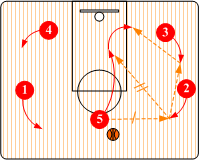
High Post Basket Cut
When O5 passes to either wing, O5 cuts to the basket anticipating a pass from O2 or O3 when the defender X5 loses vision of ball. If O5 does not receive ball on basket cut, O5 posts up.
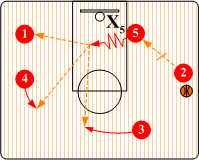
Post Up
03 looks to feed 05 isolated 1-on-1 in low post area. O5 has option of scoring or making a kick out skip pass to O1 or O2 or O4 spotting up for outside shots..
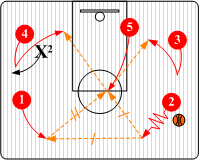
Post Flash Back Door Action
When O5 does not receive ball on post up, O2 dribbles out for spacing and O5 flashes into middle. If/when O1 or O2 passes to O5 on flash, O5 looks to feed O3 or O4 on back cuts to basket.
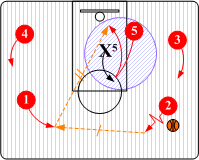
Post Flash Lob
Any time defender X5 denies O5 flash cut into the middle, O5 back cuts to the basket for possible over the top lob pass. If/when post O5 does not receive pass on flash to middle, the Princeton Offense flow directly back into any of the phase 1 entries determined by the defensive deployment.

Spacing



Spacing is a crucial element and a key factor of the Princeton Offense. Players must be aware of proper spacing at all times, and, if necessary, use their dribble to maintain proper spacing. Players are spaced between 12 and 15 feet at all times. This precise spacing spreads the defense in order to prevent or discourage any defensive help or double teaming, and at the same time it provides for sharp, accurate passing. This spreading of the defense also clears out the basket area allowing for one-on-one post play, drives, basket cuts, slice cuts, and post splits. A a result, the defense is forced to defend the entire court from sideline to sideline at all times.

Tempo & Passing
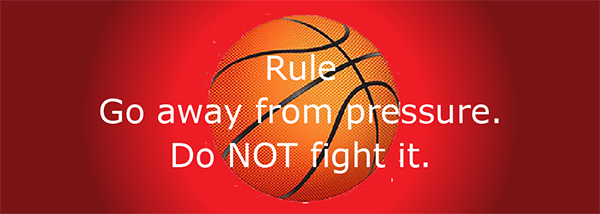
In controlling tempo, it is imperative to have patience and make the defense work and wear down. This usually means walking the ball up the floor; however, at the same time, being alert to take full advantage of quick break opportunities if/when they do arise. Controlling the ball requires good ball handling skills. It is not uncommon to make 15 to 20 passes during a possession. By controlling tempo it not only cuts down and minimizes the number of the opponent's offensive possessions, but also can create match up problems. Most opponents if/when they fall behind, are forced into taking out their "Bigs" and play small.
Players should be able to pass with either hand. Players must keep their heads up and see the floor anticipating teammates movements and counters. Despite all players handling the ball multiple times, turnovers are kept to a minimum by having the patience to make simple, safe passes and by not forcing or rushing any pass. The Princeton Offense's basic "Give and Go" passes and back door cuts are some of the oldest plays in basketball; yet, they are still among the prettiest plays in the game today.
| Back Cuts | Dribble Usage | Post Ups | Specials | Press Breaks |
Back Cut Counters vs Overplays
The classic back door cut for an easy basket is the signature of the Princeton Offense. However, open back cuts just do not happen. They are set up with ball control and good outside shooting. The constant player movement and exchanges, along with patience, has a tendency to wear down or lull even the best of defensive efforts to sleep (Condition Response). The Princeton Offense anticipates and senses defensive mistakes or let ups, and strikes without hesitation.
Since defensive pressure is the weapon of choice to disrupted the Princeton Offense, most back cuts are pressure releases against defensive overplays; however, they can, also, result from defensive errors such as loosing vision on the ball or watching the ball and loosing vision of the player that they are guarding. Following are some examples of back cuts against defensive overplays:
| Dribble Clear | High Post | High Post Flash | Diagonal Screen |
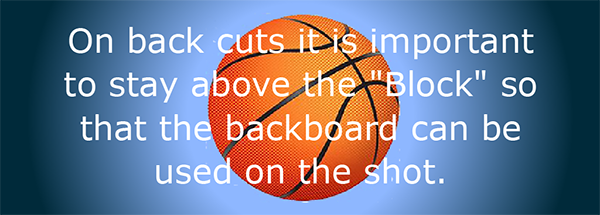
Dribble Clear Action
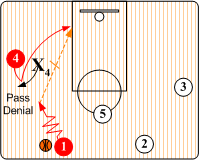
If/when defender pressures and overplays O1's entry pass to wing. O1 dribble clears the wing. O4 steps out to receive a pass, but then back cuts hard to the basket looking for a feed from O1.
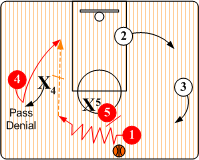
Dribble Clear action can also be initiated out mid screen action.
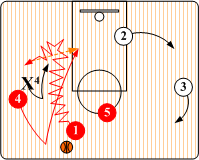
If/when the wing's defender X4 sags off to help out against dribble penetration, O1 strings outs the defense by dribbling out and looks to pass to O4 back cutting to the basket.
High Post Back Cuts
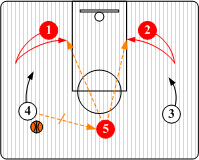
If/when a reversal pass is made to the high post and exchanges are taking place, the wings have the option of back cutting to the basket whenever the defense anticipates the exchanges.
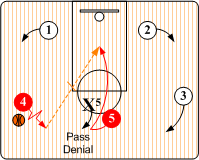
Anytime O1's defender X5 overplays and denies the reversal pass out to O5, O5 back cuts to the basket.
High Post Flashes
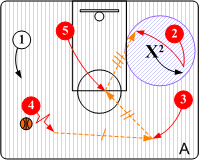
Back Cut
Out of the four out, low post alignment, when the post flashes into the middle, it keys the traditional "Back door" play.
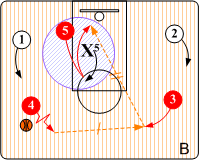
Post Lob
Anytime O5's defender X5 denies the flash cut, O5 back cuts to the basket for possible lob pass.
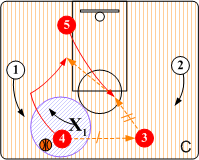
Slip Screen
On the high post back door action, O4 can slip the weakside exchange and cut to the basket looking for a feed from post O5.
Diagonal Screen Back Cut
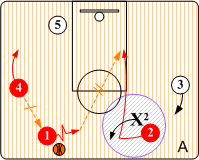
Back Cut
If/when defender X2 denies the guard to guard passing lane, O2 back cuts to basket.
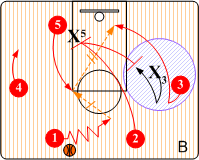
Back Screen
If/when O2 does not receive a pass on the back cut, O2 sets a diagonal down screen for the low post O5. Post O5 breaks high to receive pass from ballhandler O1 as O2 steps out to set a back screen for wing O3. O5 looks to feed O3 back cutting off O2's screen.
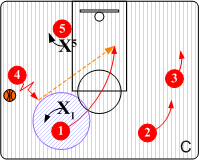
Back Cut
Whenever the defender X1 overplays the passing lane, O1 goes away from pressure and back cuts to the basket.

Dribble Penetrations
Although the Princeton Offense is primarily a passing offense, dribbling plays an important role. First of all, all five players have the "Green Light" anytime they can beat their opponent on a direct drive to the basket. However, they do not create this opportunity. They just take when it becomes available. Dribbling is used sparingly to maintain proper court spacing, execute player exchanges, and to set up special set plays. The dribble, also, becomes a valuable weapon in combating and countering defensive overplays or sagging man to man defenses.
All players, including posts, should be able to drive to the basket using either hand. It is important that players assume a head up, triple threat position and read the defense prior to putting the ball on the floor.
| Dribble Penetration | Spacing | Dribble Clear | Weave | Misdirection | Drive & Kick |
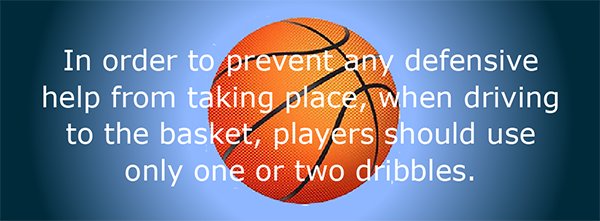
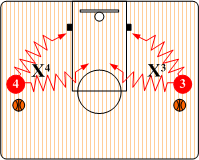
Wing Penetrations
Wings have the "Green Light" to drive directly to the basket.
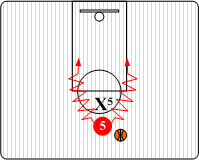
Point Penetrations
Point guards and high post players also have the "Green Light" to drive directly to the basket.
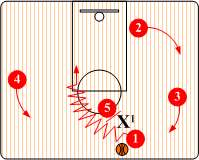
Mid Screens
Mid screens and side screens can be used to create drive opportunities.
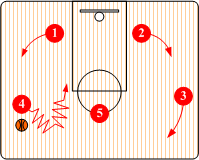
Change of Direction
Basket drives opportunities can also be created using a quick change of direction (cross over, spin, or behind the back) dribble. However, to be effective these moves must be used very sparingly during a game.
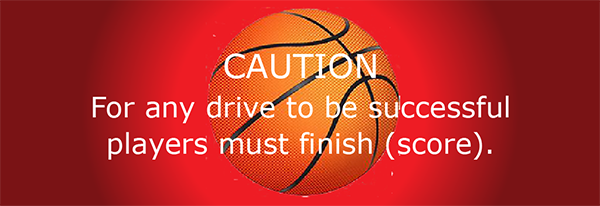
Dribble Clear
Anytime a defender overplays and denies the passing lane to the wing, much like a back door cut, the ballhandler has the automatic option of executing a dribble clear. When the ballhandler dribbles toward the receiver, the receiver back cuts to the basket for shot.
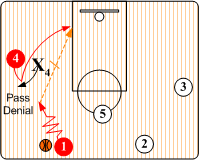
Back Cut
When defender X4 denies the passing lane to O4. O4 sets up the defender by taking a step toward the dribbler O1 and then back cuts to the basket. O1 looks to feed O4 on back cut or posting up.
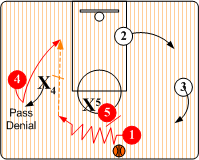
Mid Screen Back Cut
When using a mid screen, if the defender denies the wing pass, the wing can back cut to the basket interchanging positions.
Dribble Weave
Against a sagging man to man defense, the dribble hand off becomes a tactic of choice. The dribble hand off is the cornerstone of the "Old" weave offenses of the fifties. With it's multiple options, the dribble hand off can create serious problems for any team that is not prepared to defend it. In the Princeton offense, short kick out passes are used in lieu of direct hand offs.
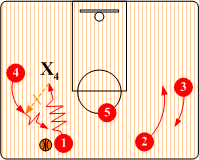
Dribble Hand off
O1 dribbles directly toward defender X4, sagging off O4, and makes a short kick out pass to O4. Since 04's defender is sagging off, this is a relatively safe way to exchange and move the basketball.
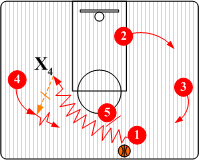
Mid Screen Dribble Hand off
The dribble weave action can also be initiated off a mid screen.
Misdirection Dribble
The use of the "Misdirection" dribble or change of direction is very effective in creating open passing lanes. Much like a magicians fool their audiences, the misdirection dribble can fool the defense.
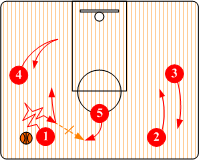
Reverse Entry
O1 dribble clears wing O4. If/when O4 is not open on back cut, O1 reverses the dribble and looks to feed the primary receiver O5.
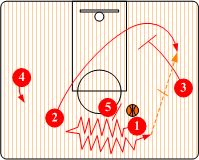
Mid Screen
Misdirection dribble action can also take place using a mid screen.
Drive and Kick
The tactic of driving all the way to the basket and making a kick out pass to set up open outside shots is used extensively in Asian basketball. When back to back drives are used, it actually turns into a very effective inside weave.
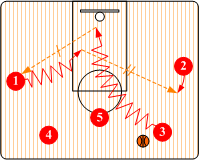
Right Side Entry
O3 drives to basket, but instead of taking a shot makes a kick out pass to O1 spotting up for an outside shot. When O1's outside shot is not available or if the defense rushes out, O1 fakes the shot and drives to the basket. O1 kicks makes a kick out pass to O2 spotting up.
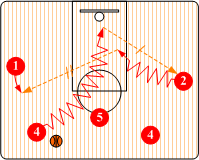
Left Side Entry
O4 drives to basket, but instead of taking a shot makes a kick out pass to O2 spotting up for an outside shot. If O2's outside shot is not available or if the defense rushes out, O2 fakes the shot and drives to the basket. O2 kicks makes a kick out pass to O1 spotting up.

Post Play
Because of its spread court, high post alignment, the Princeton offense does accentuate a low post power game. Nevertheless, by employing basket cuts and dribble clears, any player can be readily posted up. However, in the Princeton Offense post ups have the tendency to be more for kick out passes to outside shooters than they are for scoring. By employing basket cuts and dribble clears, any player can be readily posted up. However, in the Princeton Offense post ups have the tendency to be more for collapsing the defense and making kick out passes to outside shooters than they are for scoring. Post up entries can be executed at any time, from any position on either side of the court.
Point High Post Rub Entry
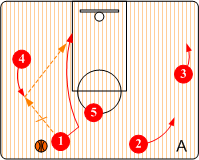
High Post Rub
Strong side guard O1 makes a wing entry pass to O4 and rubs off O5's high post screen.
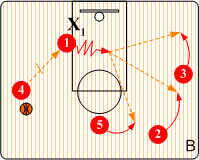
Point Post Up
If O1 is not open on basket cut, 04 looks to feed 01 posting up. O1 has option of scoring or making a kick out pass to O3 or O2 or O5 spotting up.
Weakside Guard Post Up
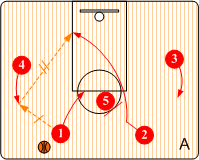
Weakside Post Rub
Ballhandler O1 passes to O4 as O2 rubs off O5's high post screen. O4 looks to feed O2 on basket cut or O1 cutting to opposite corner.
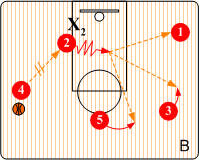
Post Up
If O2 is not open on basket cut, 04 looks to feed 02 posting up. O2, isolated 1-on-1 in low post area, has option of scoring or making a kick out pass to O3 or O2 or O5 spotting up for three point shots.
Dribble Clear Wing Post Up
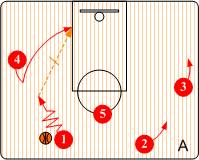
Dribble Clear
O1 dribbles clears wing O4. O1 looks to feed O4 on back cut to basket.
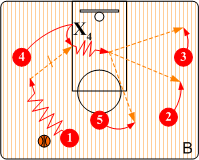
Wing Post Up
If wing o4 is not open on basket cut, 01 looks to feed 04 posting up. O4 has option of scoring or making a kick out pass to O3 or O2 or O5 spotting up for outside shots.
High Post Roll
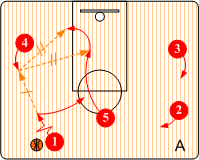
Post Roll
O1 passes to wing O4 as post O5 rolls to basket. O4 looks to feed O5 on basket cut.
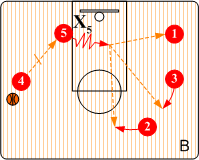
Post Up
If O5 is not open on basket roll, 04 looks to feed 05 isolated 1-on-1 in low post area. O5 has option of scoring or making a kick out pass to O3 or O2 or O1 spotting up for outside shots.

Post Actions
In the Princeton Offense scheme of attack, post ups have the tendency to be more for collapsing the defense and making kick out passes to outside shooters than they are for scoring.
| Post Isolation | Kick Out Pass | Ball Reversal |
Post Isolation
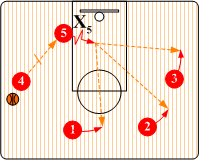
Posting Up Strong
Post 05, isolated 1-on-1 in low post area has an option of scoring or, more importantly, making a kick out pass to O1 or O2 or O3 spotting up for open outside shots.
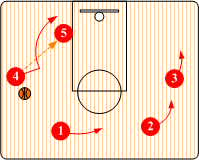
Solo Post Cut
The low post isolation also can readily flow into solo post cut action. The wing can initiates this two person game simply by feeding and cutting high or low off the low post. See Solo cut options link for more details.
Kick Out Pass to Back Cuts
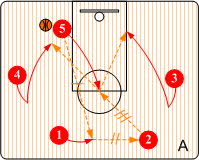
Post Flash
If/when the post makes a kick out pass to O1 and a shot is not taken, O5 flashes to high post area. O1 passes to O2, who in turn, passes to O5 flashing into the middle. When O5 receives the ball, O3 and O4 back cut to the basket.
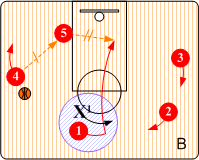
Back Cut
Anytime O1's defender X1 overplays and denies the passing lane out from O5, O1 back cuts to the basket.
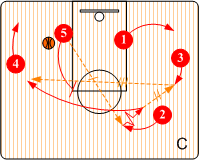
Skip Pass
If post O5 cannot feed O1 on basket cut, O5 passes out to O2 setting up weakside skip pass action. O2 passes to wing O3 and cuts to opposite wing off O5's back screen. O3 looks to make a skip pass to O2.
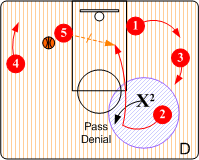
Back Cut
Anytime O2's defender denies the passing lane out from O5, O2 back cuts to the basket.

Ball Reversal
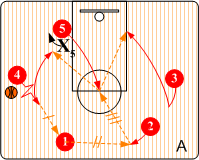
Post Flash
If/when wing cannot feed the low post, O4 makes a reversal pass off the dribble to O1 initiating the post's high post flash and back door action.
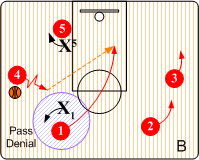
Back Cut
If/when defender X1 denies the passing lane, O1 back cuts to basket.
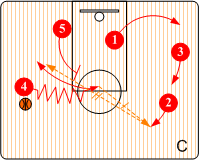
Back Screen
If wing O4 does not feed O1 on basket cut, O4 continues dribble and passes to O2. Post O5 steps out and sets a back screen for O4. O2 then looks to make a skip pass back to O4.
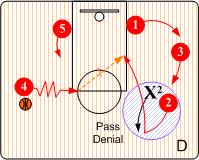
Back Cut
Anytime O2's defender denies the passing lane from O4, O2 back cuts to the basket.
Basic Post Moves - Click Here
Post Solo Cuts Reads & Counters - Click Here

Quick Hitting Specials
The Princeton offense is one of the few offenses that actually sets up plays to create open outside shots. In addition, it has the capability to flow directly into quick hitting set options anytime the shot clock winds down or at the end of a period preventing any panic or rushed shots. Set plays can also be initiated after time outs or called out at anytime. Here are some examples of quick hitting options:
High Post Split
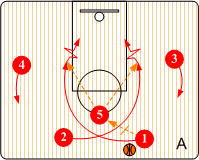
Post Split
O1 passes to high post O5, and cuts to the basket over the top of O5. O2 cuts over the top of both O1 and O5. O5 looks to feed either O1 or O2 on basket cuts.
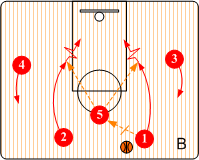
Direct Cut
O1 and O2 can make direct basket cuts rather than splitting the high post.
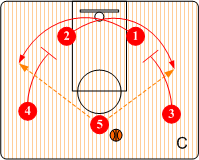
Down Screens
If O5 does not feed O1 or O2 on basket cuts, O1 and O2 cross under the basket and go off O3's and O4's down screens.
Side Screen
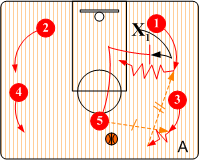
Post Screen
When O5 passes to wing and instead of making the usual basket cut, O5 steps out and sets an on ball screen for O1.
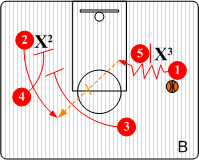
Stagger Double
O1 drives off O5's on ball screen as O3 and O4 set down screens for shooter O2. O1 looks to make a kick out pass to O2 for open three point shot.
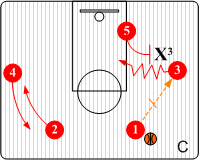
Side Screen
Side screen action can also be initiated by O5 stepping out to set an on ball screen from a low post position.
Guard Lob
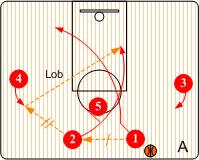
Guard Lob
O1 makes a guard to guard pass to O2 and rubs off high post O5 to opposite corner. O2 passes to wing O4 and cuts to the basket over the top of O5's back screen. O4 looks to make a over the top lob pass to O2.

Continuity
If/when the lob pass is not available, O4 makes a reversal pass out to O5 initiating wing exchange action.
Dribble Weave
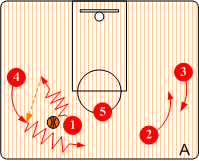
Dribble Hand off
Dribble weave action is initiated with O1's dribble penetration. If O1 cannot drive to the basket, O1 makes a kick out pass to O4 who in turn dribble penetrates over the top of O5's mid screen.
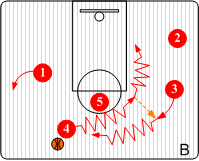
Dribble Drive
O4 looks to turn corner and drive to basket over high post's screen or make a kick out pass to O3 who continues the dribble weave action.
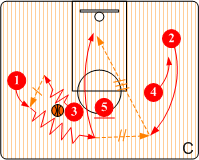
Dribble Drive
Weave action continues with O3 looking to turn corner and drive to basket or making a kick out pass to O1. If overplayed, dribbler O1 has option of passing to O2 and making a back cut to the basket off O5's back screen
Weakside Skip Pass
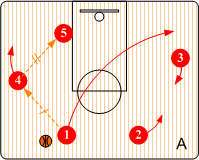
Low Post Entry
The weakside skip pass is an excellent option against teams that provide good weakside help. It starts with a low post entry. O1 passes to wing O4 and cuts to the opposite corner. O4 feeds O5 posting up low.
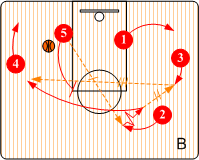
Kick Out Pass
O5 then makes a kick out pass out to O2 who in turn makes a reversal pass to O3. O5 flashes high and sets a back screen for shooter O2. O3 looks to make a cross court skip pass to O2. O2 has the options of shooting or passing to O4 spotting up in corner.
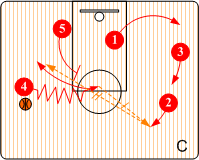
Back Screen
If/when O4 cannot feed O5 posting up, O4 dribble penetrates to the free throw line and makes a kick out pass to O2. Post O5 flashes high and sets a back screen for O4. O2 looks to make a cross court skip pass to O4 going off O5's back screen.

Press Break
Most teams will extend their defenses in an effort to increase the tempo of the game and to disrupt the Offensive flow. Full court and half court presses can be very potent defensive weapon for any team that is not prepared to attack them. However, against well prepared team, presses loose their effectiveness and can become a real liability to the defense. Therefore, teams must expect to encounter and be well prepared to counter and attack full court and half court presses.
Since press breaks will readily create outnumber situations, it is very import to practice attacking 2 on 1 and 3 on 2 situations. O3 and O4 especially need to be well taught and drilled in to attacking and finishing (scoring) on a 2 on 1 situation. Inbounders must also practice throwing long, accurate inbounds passes.
Laker Full Court Press Break - Click Here
Half Court 2-1-2 Spread Offense - Click Here

Psychological Aspects
One of the biggest weapons of the Princeton Offense is its reputation for being a giant slayer. Opposing coaches fear having to play against a team oriented offense in a low possession game, especially when there is nothing to gain and everything to lose. In addition, when playing against the Princeton Offense, they have to contend with the strong advice of "don't ever get behind" which only creates more pressure and even panic if/when they do fall behind. This fear and uncertainty, in almost all cases, is subconsciously passed onto their players.
Pressure of playing a low possession game takes away any room for mistakes. Most teams are not experienced with dealing with the tremendous mental pressure that occurs when every possession is vital to the outcome of the game. This pressure gets magnified even more during end of game crunch time.
Exposes and capitalizes on fundamentally weak defenders. Also, exposes any strong armed, inside players without outside defensive skills. Playing outside is a new adventure and they usually have no clue how to or the attitude to defend peripherally. Physically and mentally unprepared.
The easy shots that occur off back cuts against defensive overplays are very demoralizing to any defense.
Constant motion not only causes physical fatigue, but more importantly mental and spiritual fatigue. Prone to making physical and mental errors.
In and effort to speed up tempo, opponents tend to hurry and rush their shots. Turnovers are also increased by forcing and making difficult passes in the effort to speed up the game.
Dammed if you do, with back cuts. When they sag off, they loose all disruptive capabilities and are susceptible to ball control and good outside shooting.
Opponents conditioned to expect ball control tempo have a tendency to trot back on defense with backs to the ball making them vulnerable to easy transition baskets.
Slow tempo is bad for offensive team and individual player stats. Players with high stats can become very frustrated and discouraged when playing in a low possession game.
Opponents brained washed into thinking you are going to hold the ball, but in reality attacking the basket on every cut and pass. Forget to defend the basket. The threat of holding the ball, just like the threat of the dribble, is the Princeton Offense's best weapon.
Because of its patience and teamwork, the Princeton Offense, like defense, is stable and steady night after night. It is never dependent on having a hot or cold shooting night from the field.
Return to Motion Offenses - Click Here
Return to Offensive Strategies - Click Here
Return to HoopTactics - Click Here
© 2025 HoopTactics All Rights Reserved.
